Business Law: Legal System, Business Types, & Dispute Solutions
VerifiedAdded on 2024/05/14
|30
|5651
|230
Report
AI Summary
This report provides a comprehensive analysis of business law, starting with an explanation of the legal system and its sources, including legislation, case law, and international laws. It evaluates the effectiveness of the English legal system, highlighting recent reforms such as digitalization. The report then illustrates the potential impact of company, employment, and contract law on businesses, differentiating between legislation, regulations, and standards. It examines the formation of different types of business organizations, assessing their advantages and disadvantages, and concludes by recommending legal solutions for resolving disputes, comparing sources of legal advice and support, and evaluating the effectiveness of these solutions.
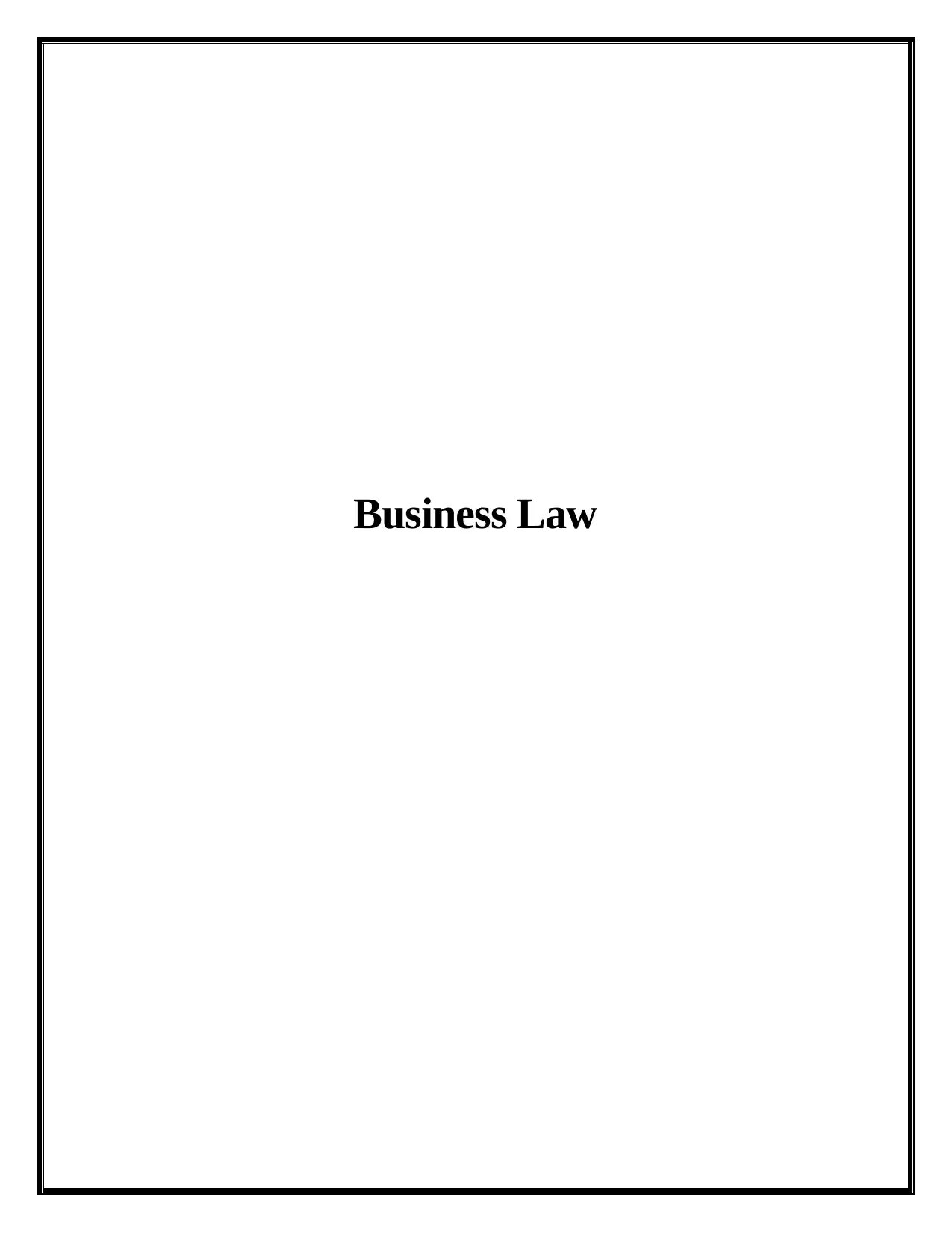
Business Law
Paraphrase This Document
Need a fresh take? Get an instant paraphrase of this document with our AI Paraphraser
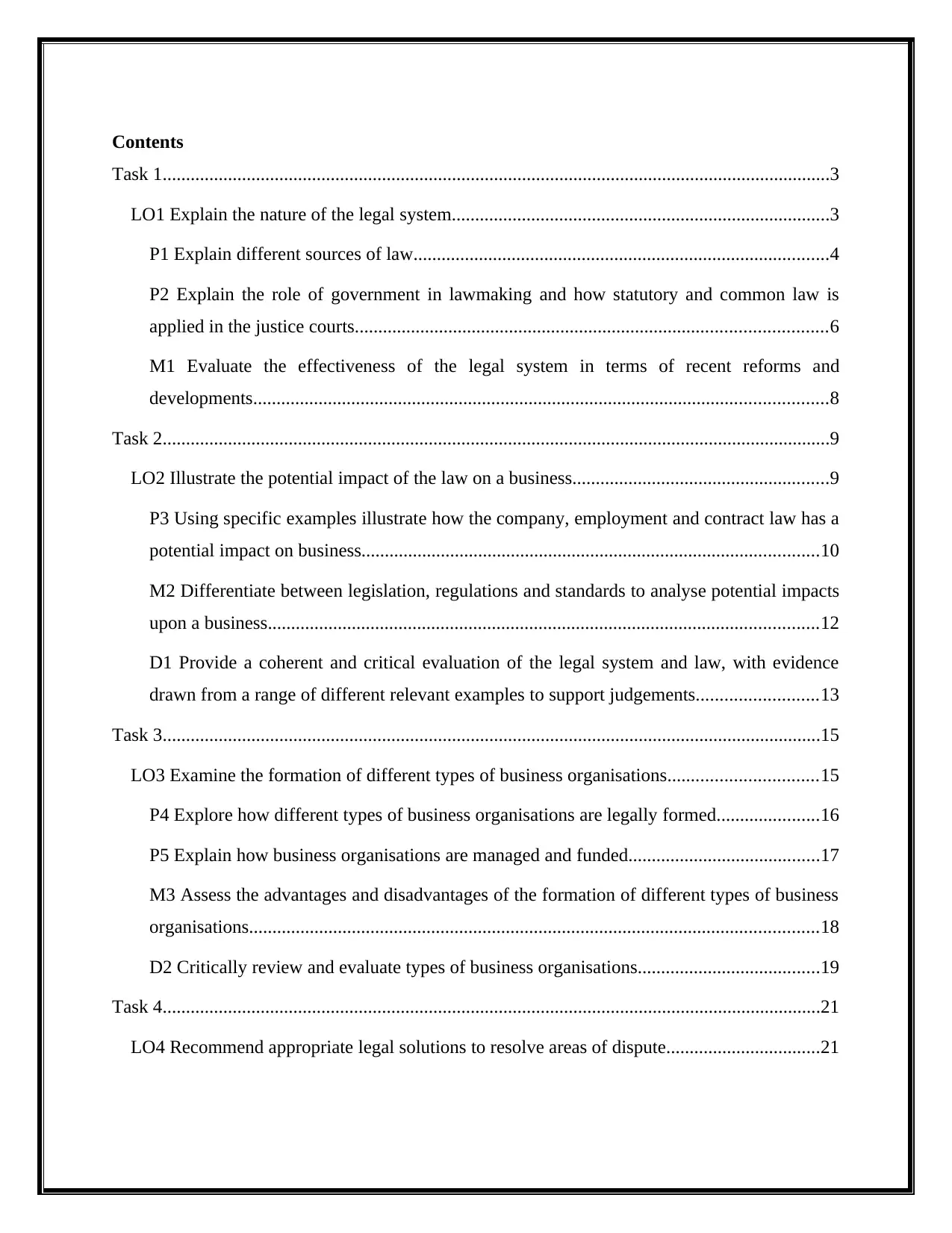
Contents
Task 1...............................................................................................................................................3
LO1 Explain the nature of the legal system.................................................................................3
P1 Explain different sources of law.........................................................................................4
P2 Explain the role of government in lawmaking and how statutory and common law is
applied in the justice courts.....................................................................................................6
M1 Evaluate the effectiveness of the legal system in terms of recent reforms and
developments...........................................................................................................................8
Task 2...............................................................................................................................................9
LO2 Illustrate the potential impact of the law on a business.......................................................9
P3 Using specific examples illustrate how the company, employment and contract law has a
potential impact on business..................................................................................................10
M2 Differentiate between legislation, regulations and standards to analyse potential impacts
upon a business......................................................................................................................12
D1 Provide a coherent and critical evaluation of the legal system and law, with evidence
drawn from a range of different relevant examples to support judgements..........................13
Task 3.............................................................................................................................................15
LO3 Examine the formation of different types of business organisations................................15
P4 Explore how different types of business organisations are legally formed......................16
P5 Explain how business organisations are managed and funded.........................................17
M3 Assess the advantages and disadvantages of the formation of different types of business
organisations..........................................................................................................................18
D2 Critically review and evaluate types of business organisations.......................................19
Task 4.............................................................................................................................................21
LO4 Recommend appropriate legal solutions to resolve areas of dispute.................................21
Task 1...............................................................................................................................................3
LO1 Explain the nature of the legal system.................................................................................3
P1 Explain different sources of law.........................................................................................4
P2 Explain the role of government in lawmaking and how statutory and common law is
applied in the justice courts.....................................................................................................6
M1 Evaluate the effectiveness of the legal system in terms of recent reforms and
developments...........................................................................................................................8
Task 2...............................................................................................................................................9
LO2 Illustrate the potential impact of the law on a business.......................................................9
P3 Using specific examples illustrate how the company, employment and contract law has a
potential impact on business..................................................................................................10
M2 Differentiate between legislation, regulations and standards to analyse potential impacts
upon a business......................................................................................................................12
D1 Provide a coherent and critical evaluation of the legal system and law, with evidence
drawn from a range of different relevant examples to support judgements..........................13
Task 3.............................................................................................................................................15
LO3 Examine the formation of different types of business organisations................................15
P4 Explore how different types of business organisations are legally formed......................16
P5 Explain how business organisations are managed and funded.........................................17
M3 Assess the advantages and disadvantages of the formation of different types of business
organisations..........................................................................................................................18
D2 Critically review and evaluate types of business organisations.......................................19
Task 4.............................................................................................................................................21
LO4 Recommend appropriate legal solutions to resolve areas of dispute.................................21

P6 Recommend legal solutions for resolving a range of disputes using examples to
demonstrate how a party might obtain legal advice and support...........................................21
M4 Compare and contrast different sources of legal advice and support for dispute
resolution...............................................................................................................................24
D3 Evaluate the effectiveness of legal solutions, legal advice and support for dispute
resolution...............................................................................................................................25
References......................................................................................................................................26
demonstrate how a party might obtain legal advice and support...........................................21
M4 Compare and contrast different sources of legal advice and support for dispute
resolution...............................................................................................................................24
D3 Evaluate the effectiveness of legal solutions, legal advice and support for dispute
resolution...............................................................................................................................25
References......................................................................................................................................26
⊘ This is a preview!⊘
Do you want full access?
Subscribe today to unlock all pages.

Trusted by 1+ million students worldwide
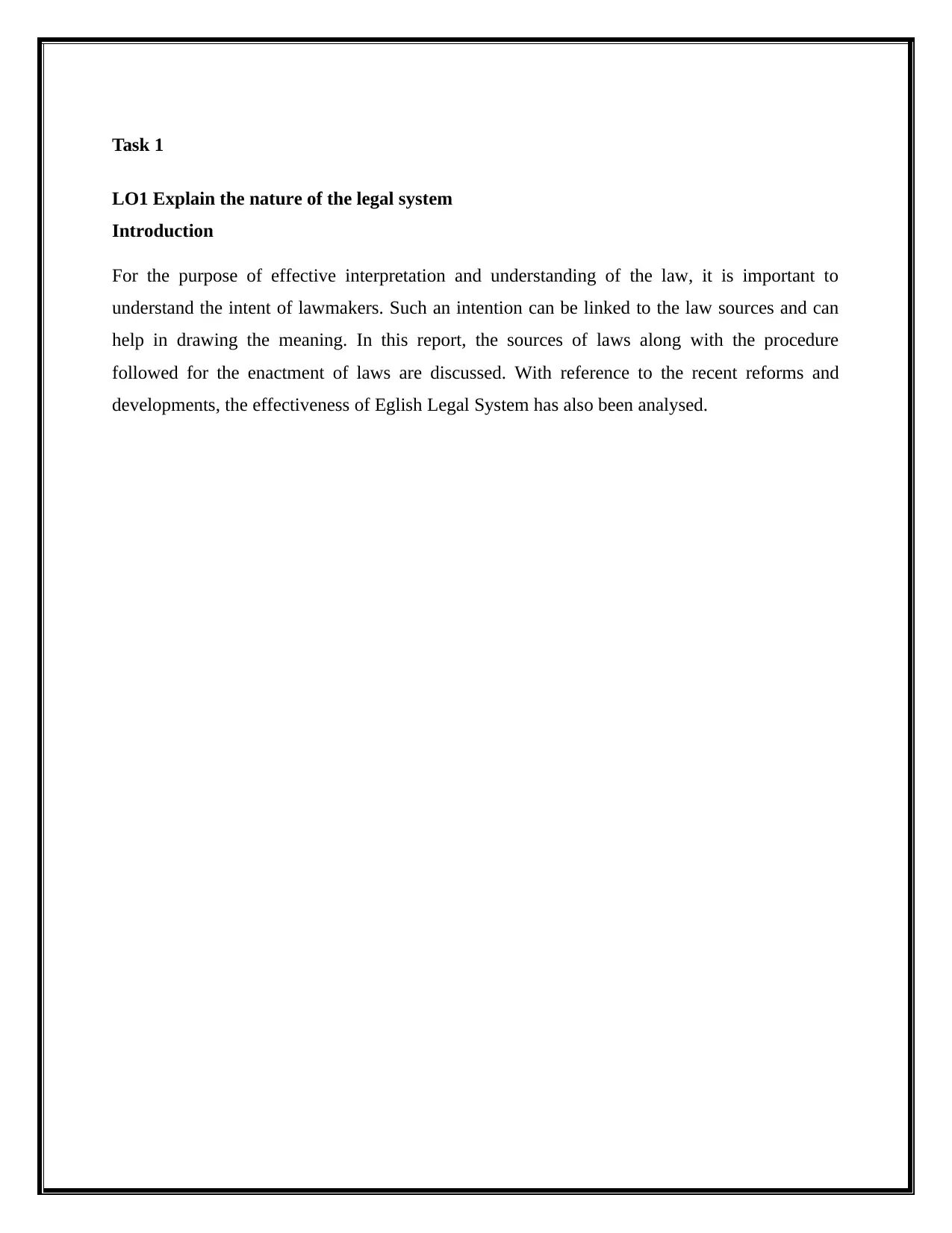
Task 1
LO1 Explain the nature of the legal system
Introduction
For the purpose of effective interpretation and understanding of the law, it is important to
understand the intent of lawmakers. Such an intention can be linked to the law sources and can
help in drawing the meaning. In this report, the sources of laws along with the procedure
followed for the enactment of laws are discussed. With reference to the recent reforms and
developments, the effectiveness of Eglish Legal System has also been analysed.
LO1 Explain the nature of the legal system
Introduction
For the purpose of effective interpretation and understanding of the law, it is important to
understand the intent of lawmakers. Such an intention can be linked to the law sources and can
help in drawing the meaning. In this report, the sources of laws along with the procedure
followed for the enactment of laws are discussed. With reference to the recent reforms and
developments, the effectiveness of Eglish Legal System has also been analysed.
Paraphrase This Document
Need a fresh take? Get an instant paraphrase of this document with our AI Paraphraser
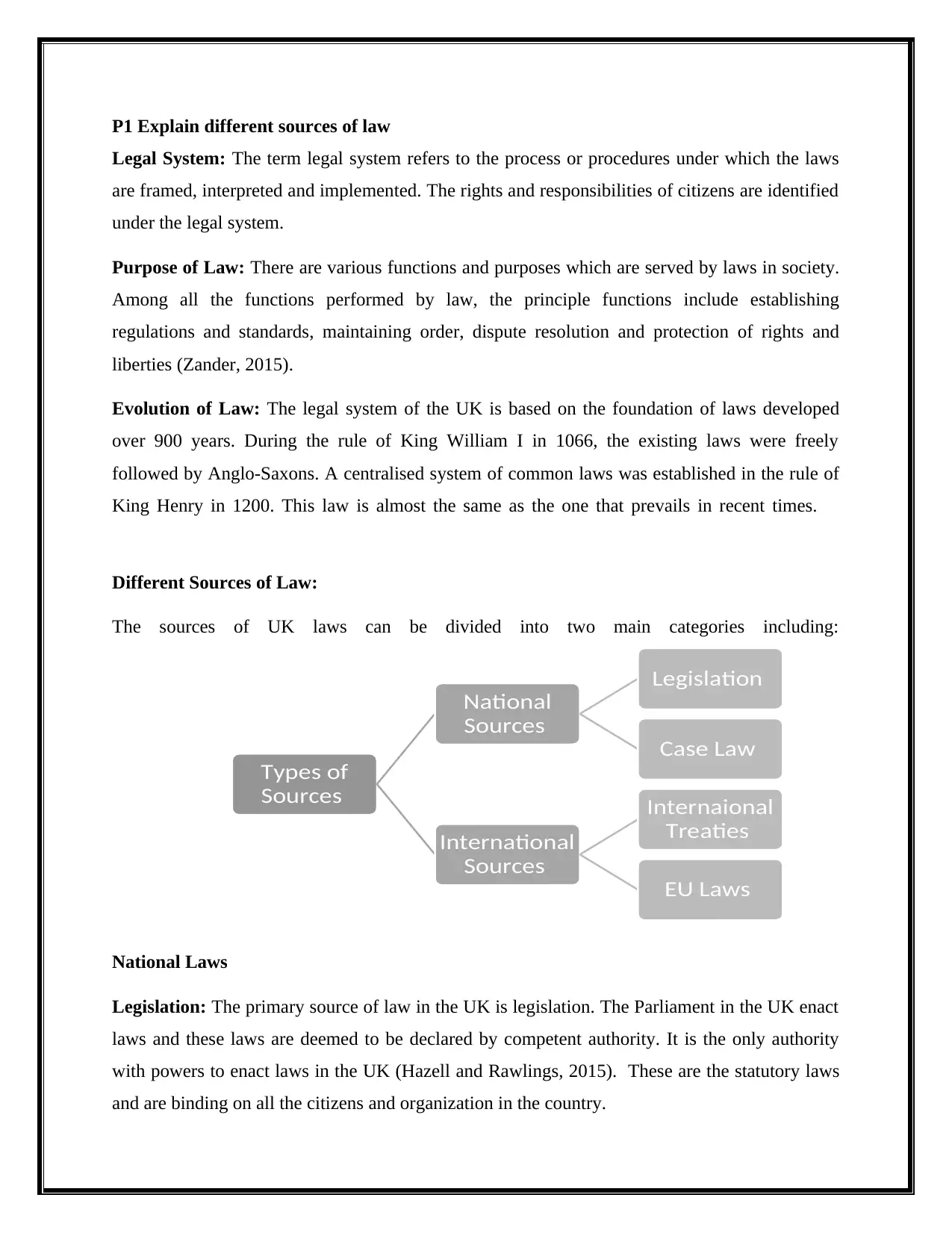
P1 Explain different sources of law
Legal System: The term legal system refers to the process or procedures under which the laws
are framed, interpreted and implemented. The rights and responsibilities of citizens are identified
under the legal system.
Purpose of Law: There are various functions and purposes which are served by laws in society.
Among all the functions performed by law, the principle functions include establishing
regulations and standards, maintaining order, dispute resolution and protection of rights and
liberties (Zander, 2015).
Evolution of Law: The legal system of the UK is based on the foundation of laws developed
over 900 years. During the rule of King William I in 1066, the existing laws were freely
followed by Anglo-Saxons. A centralised system of common laws was established in the rule of
King Henry in 1200. This law is almost the same as the one that prevails in recent times.
Different Sources of Law:
The sources of UK laws can be divided into two main categories including:
National Laws
Legislation: The primary source of law in the UK is legislation. The Parliament in the UK enact
laws and these laws are deemed to be declared by competent authority. It is the only authority
with powers to enact laws in the UK (Hazell and Rawlings, 2015). These are the statutory laws
and are binding on all the citizens and organization in the country.
Types of
Sources
National
Sources
Legislation
Case Law
International
Sources
Internaional
Treaties
EU Laws
Legal System: The term legal system refers to the process or procedures under which the laws
are framed, interpreted and implemented. The rights and responsibilities of citizens are identified
under the legal system.
Purpose of Law: There are various functions and purposes which are served by laws in society.
Among all the functions performed by law, the principle functions include establishing
regulations and standards, maintaining order, dispute resolution and protection of rights and
liberties (Zander, 2015).
Evolution of Law: The legal system of the UK is based on the foundation of laws developed
over 900 years. During the rule of King William I in 1066, the existing laws were freely
followed by Anglo-Saxons. A centralised system of common laws was established in the rule of
King Henry in 1200. This law is almost the same as the one that prevails in recent times.
Different Sources of Law:
The sources of UK laws can be divided into two main categories including:
National Laws
Legislation: The primary source of law in the UK is legislation. The Parliament in the UK enact
laws and these laws are deemed to be declared by competent authority. It is the only authority
with powers to enact laws in the UK (Hazell and Rawlings, 2015). These are the statutory laws
and are binding on all the citizens and organization in the country.
Types of
Sources
National
Sources
Legislation
Case Law
International
Sources
Internaional
Treaties
EU Laws
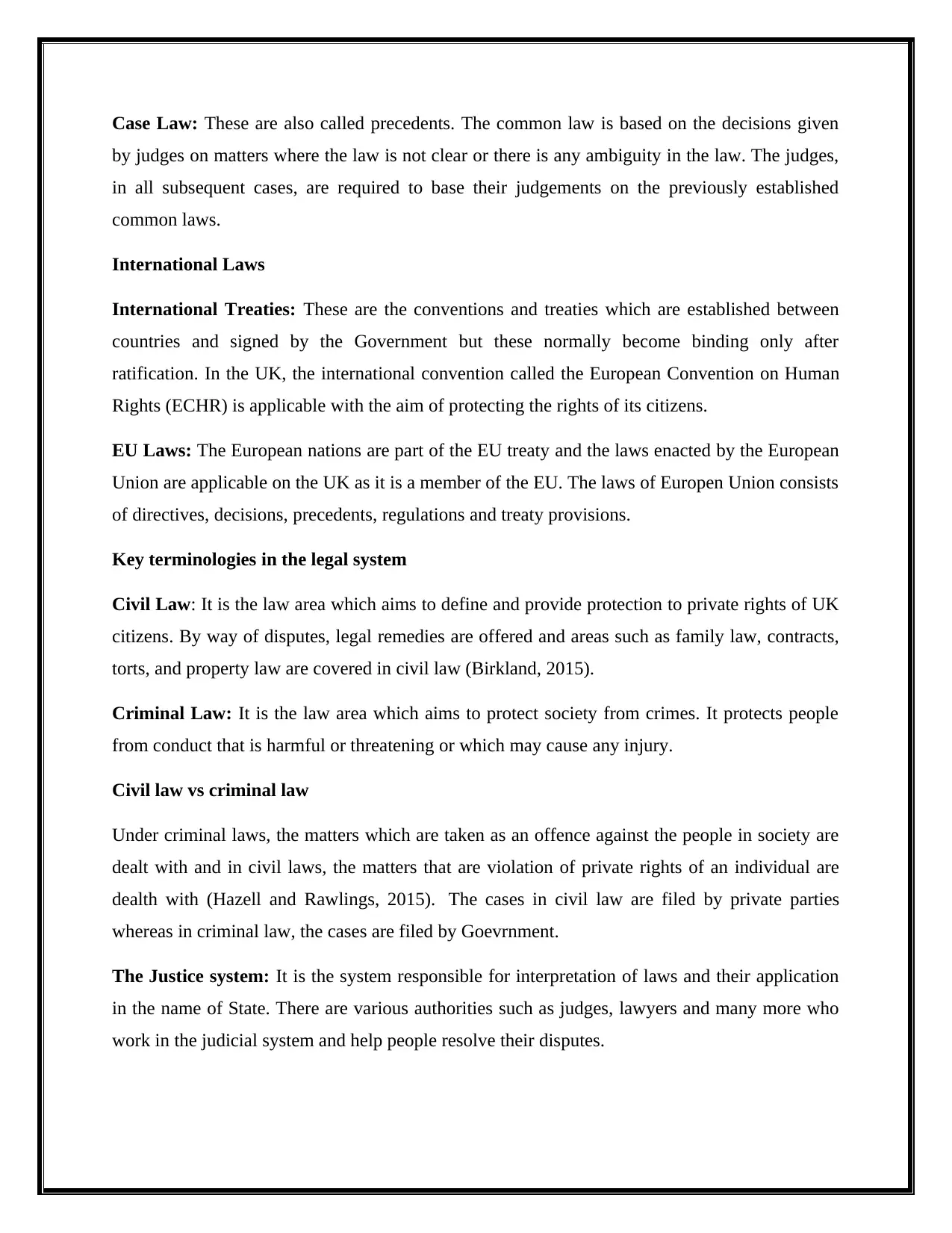
Case Law: These are also called precedents. The common law is based on the decisions given
by judges on matters where the law is not clear or there is any ambiguity in the law. The judges,
in all subsequent cases, are required to base their judgements on the previously established
common laws.
International Laws
International Treaties: These are the conventions and treaties which are established between
countries and signed by the Government but these normally become binding only after
ratification. In the UK, the international convention called the European Convention on Human
Rights (ECHR) is applicable with the aim of protecting the rights of its citizens.
EU Laws: The European nations are part of the EU treaty and the laws enacted by the European
Union are applicable on the UK as it is a member of the EU. The laws of Europen Union consists
of directives, decisions, precedents, regulations and treaty provisions.
Key terminologies in the legal system
Civil Law: It is the law area which aims to define and provide protection to private rights of UK
citizens. By way of disputes, legal remedies are offered and areas such as family law, contracts,
torts, and property law are covered in civil law (Birkland, 2015).
Criminal Law: It is the law area which aims to protect society from crimes. It protects people
from conduct that is harmful or threatening or which may cause any injury.
Civil law vs criminal law
Under criminal laws, the matters which are taken as an offence against the people in society are
dealt with and in civil laws, the matters that are violation of private rights of an individual are
dealth with (Hazell and Rawlings, 2015). The cases in civil law are filed by private parties
whereas in criminal law, the cases are filed by Goevrnment.
The Justice system: It is the system responsible for interpretation of laws and their application
in the name of State. There are various authorities such as judges, lawyers and many more who
work in the judicial system and help people resolve their disputes.
by judges on matters where the law is not clear or there is any ambiguity in the law. The judges,
in all subsequent cases, are required to base their judgements on the previously established
common laws.
International Laws
International Treaties: These are the conventions and treaties which are established between
countries and signed by the Government but these normally become binding only after
ratification. In the UK, the international convention called the European Convention on Human
Rights (ECHR) is applicable with the aim of protecting the rights of its citizens.
EU Laws: The European nations are part of the EU treaty and the laws enacted by the European
Union are applicable on the UK as it is a member of the EU. The laws of Europen Union consists
of directives, decisions, precedents, regulations and treaty provisions.
Key terminologies in the legal system
Civil Law: It is the law area which aims to define and provide protection to private rights of UK
citizens. By way of disputes, legal remedies are offered and areas such as family law, contracts,
torts, and property law are covered in civil law (Birkland, 2015).
Criminal Law: It is the law area which aims to protect society from crimes. It protects people
from conduct that is harmful or threatening or which may cause any injury.
Civil law vs criminal law
Under criminal laws, the matters which are taken as an offence against the people in society are
dealt with and in civil laws, the matters that are violation of private rights of an individual are
dealth with (Hazell and Rawlings, 2015). The cases in civil law are filed by private parties
whereas in criminal law, the cases are filed by Goevrnment.
The Justice system: It is the system responsible for interpretation of laws and their application
in the name of State. There are various authorities such as judges, lawyers and many more who
work in the judicial system and help people resolve their disputes.
⊘ This is a preview!⊘
Do you want full access?
Subscribe today to unlock all pages.

Trusted by 1+ million students worldwide

P2 Explain the role of government in lawmaking and how statutory and common law is
applied in the justice courts.
In the process of law making, the primary role of Government is to present a bill in Parliament
after analysing the problems that may need a law. Such bill may be both public or private. Public
bills are the bills containing matters that concern public at large and Private bill contains the
matters of private interest.
Law making Process
Stages Process
First Stage The title of the bill is announced to the members of Parlaiment.
Second Reading A discussion is carried out among the members of Parliament in
relation to the contents of proposed bill and the amendments are
proposed.
Committes Stage The proposed amendments are introduced in the bill and the members
carry a debate on the contents (Zander, 2015).
Third Reading In this stage, the bill is finally voted upon by the members and any
recommended cahnges are introduced.
House of Lords Here, the Members of House of Lords assess the contents of the bill
and if any changes are recommended, then the bill is sent back to
House of Commons for approval.
Royal Assent After final approval of both the Houses, the bill is sent for the Royal
Assent. After the approval of Monarch, the bill becomes law.
Application of Common and Statutory Law
Common Laws: When deciding the cases, the judges refer to the decisions of pervious case
laws, if any, of similar nature and are bound by those decisions.
Statutory Law: The rights and liabilities of people are established under statute and the judges
use these laws to determine the righst and liabilities of parties to dispute and provide them
punishments accordingly (Birkland, 2015).
applied in the justice courts.
In the process of law making, the primary role of Government is to present a bill in Parliament
after analysing the problems that may need a law. Such bill may be both public or private. Public
bills are the bills containing matters that concern public at large and Private bill contains the
matters of private interest.
Law making Process
Stages Process
First Stage The title of the bill is announced to the members of Parlaiment.
Second Reading A discussion is carried out among the members of Parliament in
relation to the contents of proposed bill and the amendments are
proposed.
Committes Stage The proposed amendments are introduced in the bill and the members
carry a debate on the contents (Zander, 2015).
Third Reading In this stage, the bill is finally voted upon by the members and any
recommended cahnges are introduced.
House of Lords Here, the Members of House of Lords assess the contents of the bill
and if any changes are recommended, then the bill is sent back to
House of Commons for approval.
Royal Assent After final approval of both the Houses, the bill is sent for the Royal
Assent. After the approval of Monarch, the bill becomes law.
Application of Common and Statutory Law
Common Laws: When deciding the cases, the judges refer to the decisions of pervious case
laws, if any, of similar nature and are bound by those decisions.
Statutory Law: The rights and liabilities of people are established under statute and the judges
use these laws to determine the righst and liabilities of parties to dispute and provide them
punishments accordingly (Birkland, 2015).
Paraphrase This Document
Need a fresh take? Get an instant paraphrase of this document with our AI Paraphraser

Organization of Judiciary
Topic: Organization of Judiciary
Source: (Birkland, 2015).
Topic: Organization of Judiciary
Source: (Birkland, 2015).
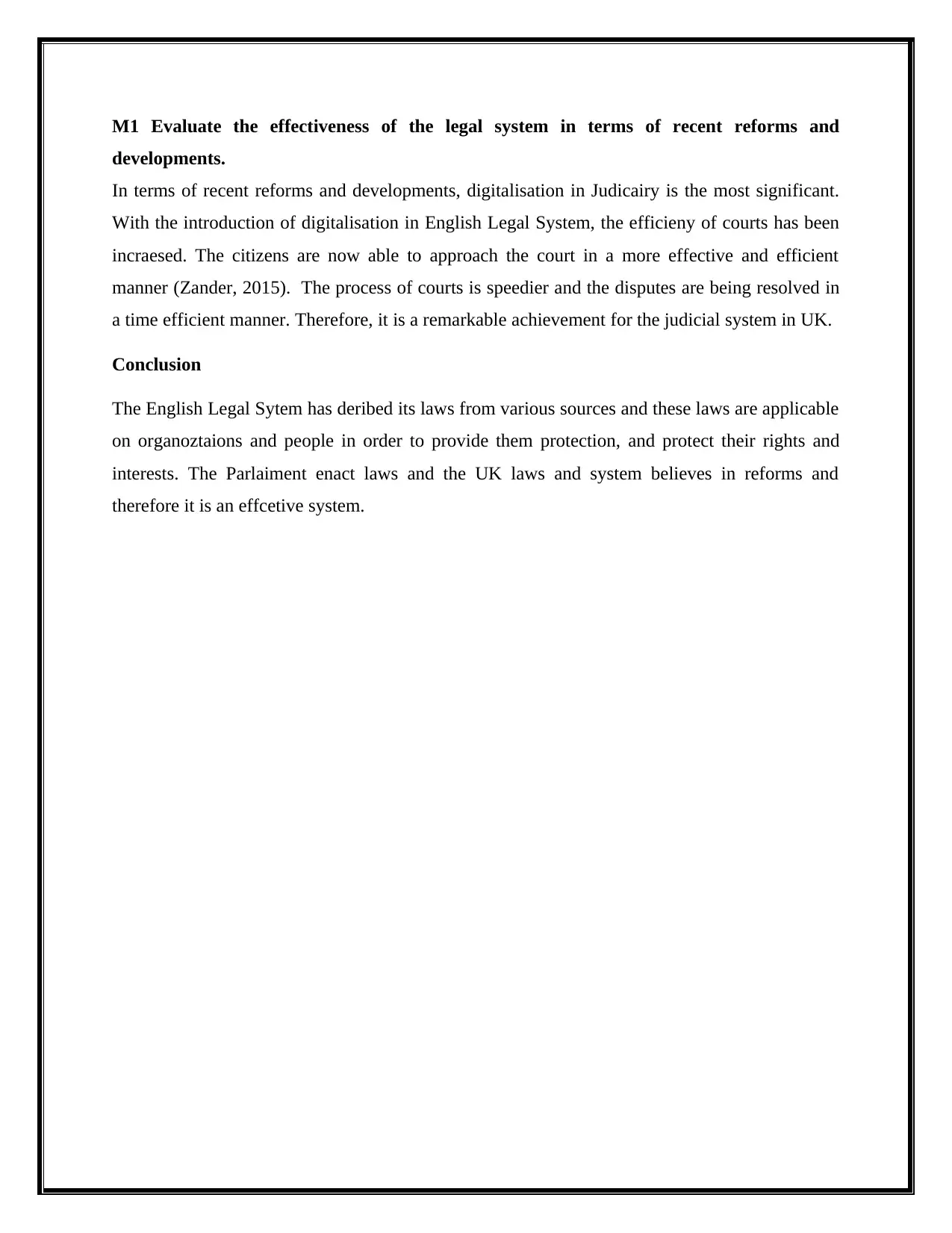
M1 Evaluate the effectiveness of the legal system in terms of recent reforms and
developments.
In terms of recent reforms and developments, digitalisation in Judicairy is the most significant.
With the introduction of digitalisation in English Legal System, the efficieny of courts has been
incraesed. The citizens are now able to approach the court in a more effective and efficient
manner (Zander, 2015). The process of courts is speedier and the disputes are being resolved in
a time efficient manner. Therefore, it is a remarkable achievement for the judicial system in UK.
Conclusion
The English Legal Sytem has deribed its laws from various sources and these laws are applicable
on organoztaions and people in order to provide them protection, and protect their rights and
interests. The Parlaiment enact laws and the UK laws and system believes in reforms and
therefore it is an effcetive system.
developments.
In terms of recent reforms and developments, digitalisation in Judicairy is the most significant.
With the introduction of digitalisation in English Legal System, the efficieny of courts has been
incraesed. The citizens are now able to approach the court in a more effective and efficient
manner (Zander, 2015). The process of courts is speedier and the disputes are being resolved in
a time efficient manner. Therefore, it is a remarkable achievement for the judicial system in UK.
Conclusion
The English Legal Sytem has deribed its laws from various sources and these laws are applicable
on organoztaions and people in order to provide them protection, and protect their rights and
interests. The Parlaiment enact laws and the UK laws and system believes in reforms and
therefore it is an effcetive system.
⊘ This is a preview!⊘
Do you want full access?
Subscribe today to unlock all pages.

Trusted by 1+ million students worldwide
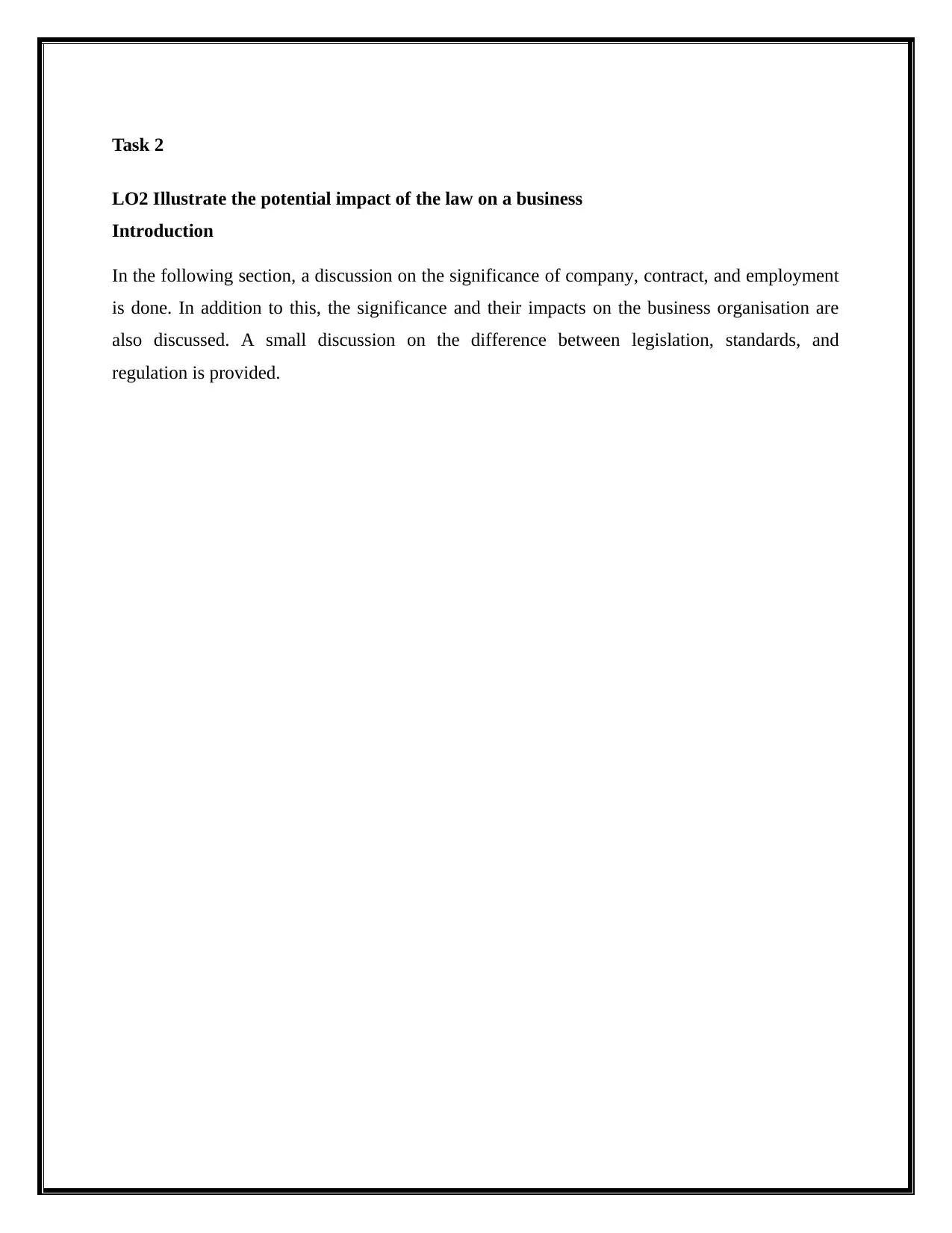
Task 2
LO2 Illustrate the potential impact of the law on a business
Introduction
In the following section, a discussion on the significance of company, contract, and employment
is done. In addition to this, the significance and their impacts on the business organisation are
also discussed. A small discussion on the difference between legislation, standards, and
regulation is provided.
LO2 Illustrate the potential impact of the law on a business
Introduction
In the following section, a discussion on the significance of company, contract, and employment
is done. In addition to this, the significance and their impacts on the business organisation are
also discussed. A small discussion on the difference between legislation, standards, and
regulation is provided.
Paraphrase This Document
Need a fresh take? Get an instant paraphrase of this document with our AI Paraphraser
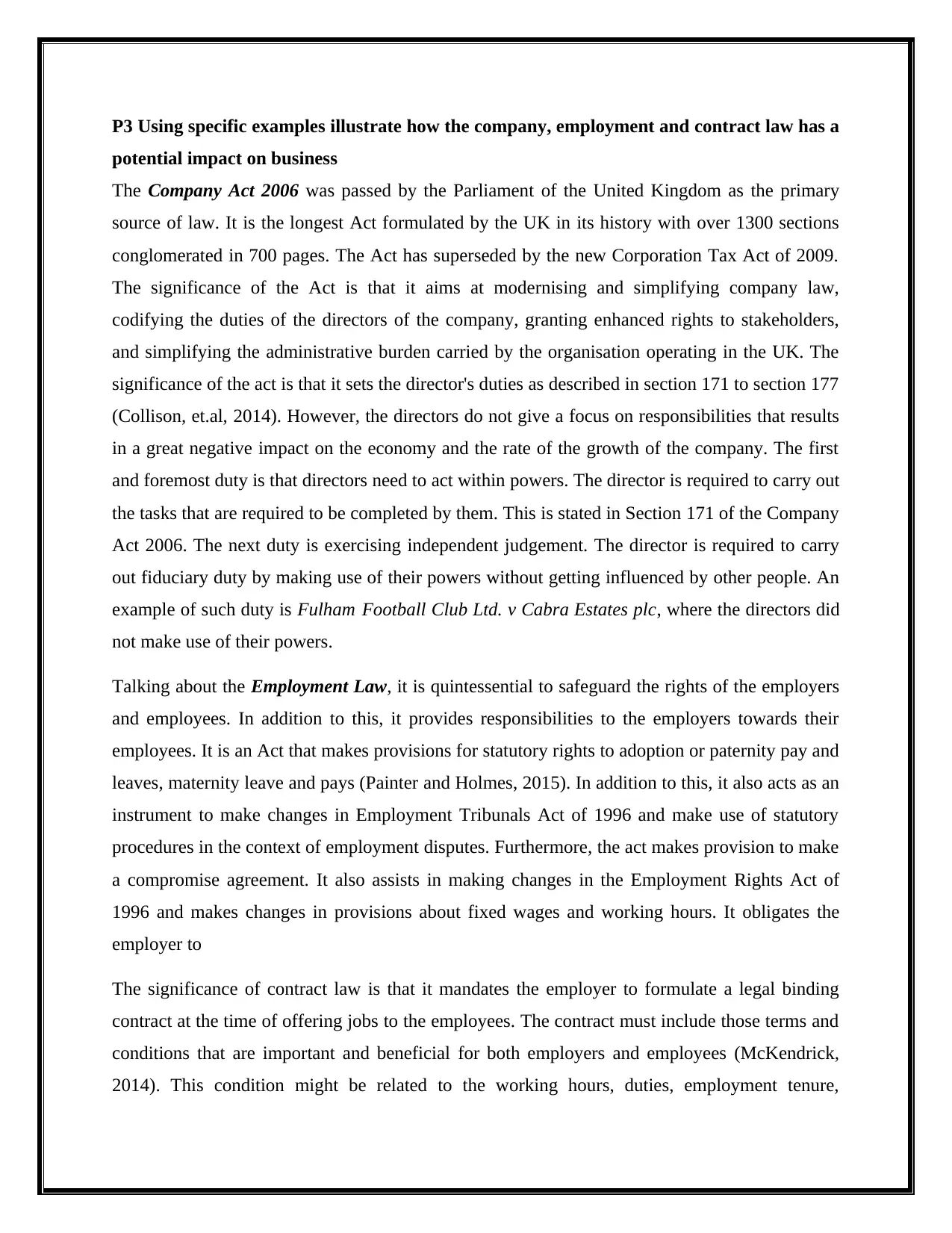
P3 Using specific examples illustrate how the company, employment and contract law has a
potential impact on business
The Company Act 2006 was passed by the Parliament of the United Kingdom as the primary
source of law. It is the longest Act formulated by the UK in its history with over 1300 sections
conglomerated in 700 pages. The Act has superseded by the new Corporation Tax Act of 2009.
The significance of the Act is that it aims at modernising and simplifying company law,
codifying the duties of the directors of the company, granting enhanced rights to stakeholders,
and simplifying the administrative burden carried by the organisation operating in the UK. The
significance of the act is that it sets the director's duties as described in section 171 to section 177
(Collison, et.al, 2014). However, the directors do not give a focus on responsibilities that results
in a great negative impact on the economy and the rate of the growth of the company. The first
and foremost duty is that directors need to act within powers. The director is required to carry out
the tasks that are required to be completed by them. This is stated in Section 171 of the Company
Act 2006. The next duty is exercising independent judgement. The director is required to carry
out fiduciary duty by making use of their powers without getting influenced by other people. An
example of such duty is Fulham Football Club Ltd. v Cabra Estates plc, where the directors did
not make use of their powers.
Talking about the Employment Law, it is quintessential to safeguard the rights of the employers
and employees. In addition to this, it provides responsibilities to the employers towards their
employees. It is an Act that makes provisions for statutory rights to adoption or paternity pay and
leaves, maternity leave and pays (Painter and Holmes, 2015). In addition to this, it also acts as an
instrument to make changes in Employment Tribunals Act of 1996 and make use of statutory
procedures in the context of employment disputes. Furthermore, the act makes provision to make
a compromise agreement. It also assists in making changes in the Employment Rights Act of
1996 and makes changes in provisions about fixed wages and working hours. It obligates the
employer to
The significance of contract law is that it mandates the employer to formulate a legal binding
contract at the time of offering jobs to the employees. The contract must include those terms and
conditions that are important and beneficial for both employers and employees (McKendrick,
2014). This condition might be related to the working hours, duties, employment tenure,
potential impact on business
The Company Act 2006 was passed by the Parliament of the United Kingdom as the primary
source of law. It is the longest Act formulated by the UK in its history with over 1300 sections
conglomerated in 700 pages. The Act has superseded by the new Corporation Tax Act of 2009.
The significance of the Act is that it aims at modernising and simplifying company law,
codifying the duties of the directors of the company, granting enhanced rights to stakeholders,
and simplifying the administrative burden carried by the organisation operating in the UK. The
significance of the act is that it sets the director's duties as described in section 171 to section 177
(Collison, et.al, 2014). However, the directors do not give a focus on responsibilities that results
in a great negative impact on the economy and the rate of the growth of the company. The first
and foremost duty is that directors need to act within powers. The director is required to carry out
the tasks that are required to be completed by them. This is stated in Section 171 of the Company
Act 2006. The next duty is exercising independent judgement. The director is required to carry
out fiduciary duty by making use of their powers without getting influenced by other people. An
example of such duty is Fulham Football Club Ltd. v Cabra Estates plc, where the directors did
not make use of their powers.
Talking about the Employment Law, it is quintessential to safeguard the rights of the employers
and employees. In addition to this, it provides responsibilities to the employers towards their
employees. It is an Act that makes provisions for statutory rights to adoption or paternity pay and
leaves, maternity leave and pays (Painter and Holmes, 2015). In addition to this, it also acts as an
instrument to make changes in Employment Tribunals Act of 1996 and make use of statutory
procedures in the context of employment disputes. Furthermore, the act makes provision to make
a compromise agreement. It also assists in making changes in the Employment Rights Act of
1996 and makes changes in provisions about fixed wages and working hours. It obligates the
employer to
The significance of contract law is that it mandates the employer to formulate a legal binding
contract at the time of offering jobs to the employees. The contract must include those terms and
conditions that are important and beneficial for both employers and employees (McKendrick,
2014). This condition might be related to the working hours, duties, employment tenure,

appraisal guidelines, working hours, and responsibilities, grounds and condition to expel. It also
comprises the penalties in case of breach of contract.
comprises the penalties in case of breach of contract.
⊘ This is a preview!⊘
Do you want full access?
Subscribe today to unlock all pages.

Trusted by 1+ million students worldwide
1 out of 30
Related Documents
Your All-in-One AI-Powered Toolkit for Academic Success.
+13062052269
info@desklib.com
Available 24*7 on WhatsApp / Email
![[object Object]](/_next/static/media/star-bottom.7253800d.svg)
Unlock your academic potential
Copyright © 2020–2025 A2Z Services. All Rights Reserved. Developed and managed by ZUCOL.